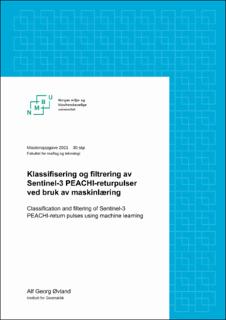| dc.contributor.advisor | Breili, Kristian | |
| dc.contributor.advisor | Ophaug, Vegard | |
| dc.contributor.advisor | Tomic, Oliver | |
| dc.contributor.author | Øvland, Alf Georg | |
| dc.date.accessioned | 2021-11-29T12:31:26Z | |
| dc.date.available | 2021-11-29T12:31:26Z | |
| dc.date.issued | 2021 | |
| dc.identifier.uri | https://hdl.handle.net/11250/2831918 | |
| dc.description.abstract | I denne gradsoppgaven utforskes potensialet til Sentinel-3 PEACHI-data langs Norskekysten. To filtreringsmetoder blir utprøvd for å fjerne observasjoner som forventes å gi feil avstandsmåling, hovedsakelig forårsaket av landkontaminering og ulike refleksjonsegenskaper på havoverflata. Et kystsnitt blir beregnet for å finne den beste filtreringsmetoden for hele kysten. Den ene filtreringsmetoden baserer seg på grovfeilsøk på avstandsmålingen med Student's multippel-t test. Den andre metoden baserer seg på klassifisering av returpulsens form ved bruk av maskinlæring. For sistnevnte blir tre ulike maskinlæringsmodeller testet for å finne den beste for oppgaven. I tillegg blir en cluster-modell testet for å se om den karer å finne ønskede returpuls-egenskaper.
Maskinlæringsmodellene Dense, CNN HSI og CNN oppnår klassifiserings-nøyaktighet på henholdsvis 66.3%, 63.4% og 68.2%. Cluster-algoritmen K-Means fant ikke ønskede egenskaper og ble derfor ikke benyttet i videre beregninger. Etter evaluering av maskinlæringsmodellene ved bruk av forvirringsmatriser ble CNN-modellen valgt til å predikere pulsklasser i valideringsområder rundt vannstandsmålerne.
Filtreringsmetodene blir hver for seg validert ved dynamisk havtopografi med fasit fra permanente vannstandsmålere. Deretter sammenliknet med hverandre. Enkelte vannstandsmålere måtte utelates av kystsnittet på grunn av få observasjoner etter filtreringsmetoden som bruker maskinlæring. Student's multippel-t test gir differanse, standardavvik, median absolute deviation (MAD) og Spearman-korrelasjon på henholdsvis 21.6 mm, 111.8 mm og 0.8724. Klassifisering basert på returpulsens form gir differanse, standardavvik, MAD og Spearman-korrelasjon på henholdsvis 9.3 mm, 103.0 mm og 0.8786. Det tilsvarer en prosentvis endring på -57.1%, -7.9%, 0.7% og -3.4%, for henholdsvis differanse, standardavvik, Spearman-korrelasjon og MAD.
Resultatene indikerer at filtrering ved maskinlæringsmetoden egner seg bedre for kystaltimetri langs Norskekysten. Sentinel-3 SAR-observasjoner gir bedre resultater enn Sentinel-3 PEACH-observasjoner
når man sammenlikner med liknende tidligere arbeid. | en_US |
| dc.description.abstract | In this thesis, the potential of Sentinel-3 PEACHI data along the Norwegian coast line is explored. Two filtration methods are being tested to remove observations that are expected to give incorrect distance measurement, mainly caused by land contamination and various reflection properties of the sea surface. A coastal mean is calculated to find the best filtration method for the entire coast. One filtering method is based outlier detection, using the distance measurement with Student's multiple-t test. The second method is based on the classification of the shape of the return pulse using machine learning. For the latter, three different machine learning models are tested to find the best one for this task. In addition, a cluster model is tested to see if it can find the desired return pulse properties.
The machine learning models, Dense, CNN HSI og CNN achieves classification accuracy of 66.3 %, 63.4 % and 68.2 %, respectively. The cluster algorithm K-Means did not find the desired properties and was therefore not used in further calculations. After evaluating the machine learning models using confusion matrices, the textit CNN model was chosen to predict pulse-classes in validation areas around the water level gauges.
The filtration methods are individually validated by dynamic sea topography with results from permanent water level gauges. Then compared with each other. Some water level gauges had to be omitted from the coastal mean due to few observations according to the filtration method that uses machine learning. Student's multiple-t test gives difference, standard deviation, textit median absolute deviation (MAD) and Spearman correlation of 21.6 mm, 111.8 mm and 0.8724, respectively. Classification based on the shape of the return pulse gives the difference, standard deviation, MAD and Spearman correlation of 9.3 mm, 103.0 mm and 0.8786, respectively. This corresponds to a percentage change of -57.1 %, -7.9 %, 0.7 % and -3.4 %, for difference, standard deviation, Spearman correlation and MAD, respectively.
The results indicate that filtering by the machine learning method is better suited for coastal altimetry along the Norwegian coast. Sentinel-3 SAR observations give better results than Sentinel-3 PEACHI observations when compared to similar previous work. | en_US |
| dc.language.iso | nob | en_US |
| dc.publisher | Norwegian University of Life Sciences, Ås | en_US |
| dc.rights | Attribution-NonCommercial-NoDerivatives 4.0 Internasjonal | * |
| dc.rights.uri | http://creativecommons.org/licenses/by-nc-nd/4.0/deed.no | * |
| dc.title | Klassifisering og filtrering av Sentinel-3 PEACHI-returpulser ved bruk av maskinlæring | en_US |
| dc.title.alternative | Classification and filtering of Sentinel-3 PEACHI-return pulses using machine learning | en_US |
| dc.type | Master thesis | en_US |
| dc.description.localcode | M-GEOM | en_US |

